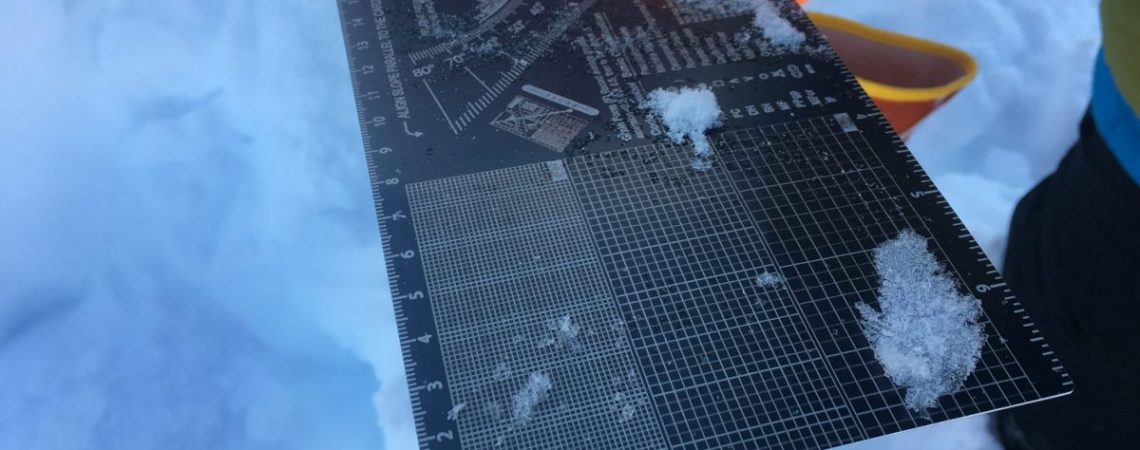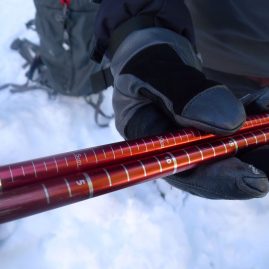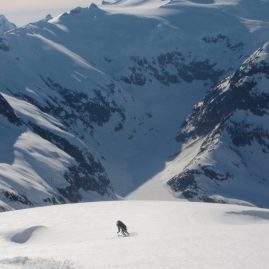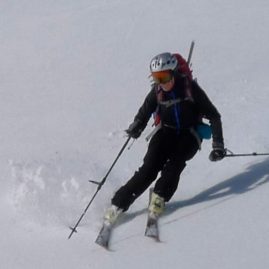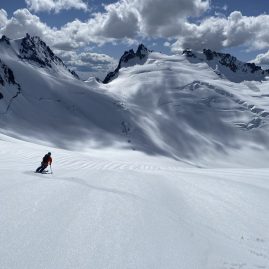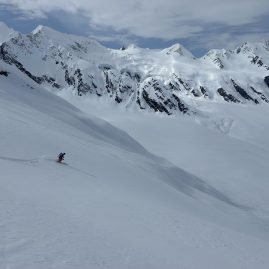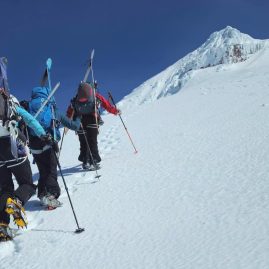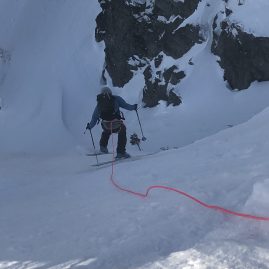-
- Lecture and Zoom Dates: 2025-26 Tuesday & Friday @6:30 PM
- Snoqualmie Field Dates Dec 28-29; January 18-19; February 1-2
- Women’s Field Dates January 18-19
- Duration: 3 Days/4 Days with Avalanche Rescue
- Level: Intermediate
- Client Ratio: 5:1
- Cost:$555/ $695 with Rescue
- Included: Instruction, Student Manual, AIARE Field Book, Online Learning Module,1 evening lecture, 2 Field Days
- Not Included: Transportation, personal equipment, Avalanche Handbook & gratuities
Looking how to remove the ‘Mystique of how not to die in an avalanche?‘ Maps, steeps and slabs stand in the way of planning a great tour so what to do? AIARE Advanced Avalanche/Touring Level 2 steps up to longer, more committing tours and decision making in more complex terrain and address the question, how am I affecting the snow? We take your knowledge built from your AIARE Level 1 and Intro to Touring and develop skills for navigation, snowpack/terrain evaluation and steep touring techniques. We follow the American Avalanche Association Level 2 curriculum and blend in advanced touring skill development to expand your tools for evaluating and executing longer and more complex tours and climbs.
Our Level 2 Avalanche/Touring Curriculum covers:
- Observation factors that affect or indicate snow stability
- Observation guidelines for weather, snowpack, and avalanches
- Propagation tests & test profiles
- Introduce slope scale stability analysis and forecasting
- Avalanche terrain recognition, slab mechanics and skier triggering concepts
- Complex Terrain travel techniques, route selection and decision making
Level 2 Avalanche Course Outline
Online Learning Modules
Take your time over the course of several days to allow yourself time to go through the material , usually (3-4 hours) to prepare for the Zoom Session.
Evening 1
ZOOM CLASSROOM- TUESDAY 6:00-9:00 pm
Instructor and Student Introductions, Course Objectives,
Course Itinerary and Logistics, Liability Release Forms
Level 1 Quiz and Review
Case Study
Mountain Weather
Review of Seasonal Snowpack
Formation and Classification of New Snow
Metamorphism, Sintering and Bonding
Weak Layers Characteristics
Snowpack Data Classes and Instability Factors
Recording Observations
Making Observations Relevant
Comparison of Shear Quality and Fracture Character :
Evening 1
ZOOM CLASSROOM- FRIDAY 6:00-8:00 pm
Review the Forecast and work thru the planning process
Field Day 1
Field Weather Demo
Test Snow Profile Demo/Large Column Tests(ECT/PST)
AM Stability Analysis/AM Weather Update/Stability Forecast
Trip Planning and Risk Management for Small Groups
Group Tour
Gathering Information/Observations over Terrain
Field Day 2
AM Stability Analysis/AM Weather Update/Stability Forecast :
Trip Planning and Risk Management for Small Groups
Group Tour
Verify Stability Forecast
Group Management / Terrain Selection/Travel Techniques
Return to Classroom
Tour Debrief
PM Instability Analysis
Course Close
Touring Gear
- Adjustable Ski poles with powder (big) baskets*
- Skis or snowboard.Skis should be equipped with alpine touring bindings or telemark bindings. We prefer split decision snowboards w/ skins because you do not need snow shoes.
- Alpine touring, telemark, or snowboard boots
- Snowshoes for snowboarders
- Skins with glop stopper (skin wax)
- Avalanche Beacon This needs to be Triple Antenna.
- Shovel Small collapsible style
- Avalanche Probe 265cm or longer
- Helmet for riding and climbing adjustable to fit over hats
Snow Study Kit
- Loupe- I found these 15X loupes work well- https://www.google.com/search?q=snow+loupe#oshopproduct=pid:7454447866363306168,oid:7454447866363306168,iid:9026991195942430826,pvt:hg,pvo:3&oshop=apv&pvs=0
- Polycarbonate Crystal Card-https://backcountryaccess.com/product-category/snow-study-tools-skins/
- Therometer(Cooper Atkins 450W-same one in the Snowmetrics digital kit, love it!)
- Snowstudy case i use is the Rite-in the rain, made of cordura. http://www.rainwriter.com/Covers-s/1874.htm
Other good cases are the Snow Metrics .
Upper Body
- Lightweight base layer T-shirt or long sleeve polypropylene shirt
- Soft Shell
- 1 Down/synthetic jacket with hood
- 1 Hard shell jacket with hood Waterproof and breathable. roomy enough to fit over multiple layers.
- 1 pair liner gloves Thin wool or polypropylene
- Shell gloves or mitts
- Warm hat Wool or synthetic
- Balaclava or Buff
- Shade hat or baseball cap
Lower Body
- 1 pair heavy wool/synthetic socks Check boot fit with liner and wool socks on
- 1 pair lightweight long underwear Polypropylene or Capilene
- Soft shell pants with Schoeller fabrics
- Shell pants Waterproof/breathable with full side zips, Gore-Tex or equivalent is best
Backpack
- Internal frame pack 2000-2500 cubic inch capacity, avoid unnecessary options that add weight
Miscellaneous Equipment
- Sunglasses 100% UV protection
- Personal first aid kit Basics: moleskin/blister kit, Band-Aids, first-aid tape, ibuprofen, personal medications, etc.
- Lip balm At least SPF 20,
- Sunscreen At least SPF 40
- Headlamp compact LED
- 2 water bottles 1 liter wide-mouth Nalgene and 1 bottle holster, or
- Multi-tool.
- Bandana
- Hand wipes
- 1 small stainless steel thermos (Optional)
- Lunch & snack food (no more than 2 pounds)
- Camera
WILL MY GUIDE (OR GUIDES) BE?
You will receive an introductory email with the instructor for your course. We are small company who enjoy working together in the mountains as well as highly skilled professionals who hold current Wilderness First Responder certification and are proficient in technical rescue and evacuation skills. Our guides are dedicated to the world of alpinism, many having first ascents and hold professional certifications with AIARE & AMGA. The AMGA is part of the IFMGA, which is the international body of certified mountain guides.
HOW MUCH SHOULD I TIP MY GUIDES?
Tipping is considered standard practice in the guiding industry. Tipping amounts vary – so $20-30 per day per person/per guide is average that works well for the guides without a serious blow to your wallet. Often 10% of the course cost is a good rule-of-thumb. If you feel that the program was exceptional or substandard the tip can reflect that.
CAN I RENT EQUIPMENT FROM BCAG?
If you need these plus touring equipment, Ascent Outdoors rents avalanche safety equipment, alpine touring, tele and split boards click here. Quantities are limited so please contact us as soon as possible if you are interested.
HOW HEAVY WILL MY PACK BE?
You will carry 10-15 pounds, which will include everything on the equipment list.
WHEN DO I NEED TO PAY THE BALANCE OF MY TRIP?
Payable when you make your reservation by check, or credit card.
WHAT HAPPENS IF I NEED TO CANCEL MY TRIP?
If you should decide to cancel your trip, BCAG must be notified in writing. Your trip will be cancelled from the date we receive written notice. You will be assessed a cancellation fee according to the following schedule:
90 to 22 days from trip departure – 50% of trip cost
30 days or less – 100% of trip cost
WHAT HAPPENS IF I WANT TO CHANGE THE DATES OF MY TRIP?
Schedule changes are subject to a $50 fee per person up to 2 weeks out and $100 less then 14 days from the start of the trip and may not be possible. If conditions or circumstances preclude running a scheduled program we reserve the right to make the decision as to whether the program will be canceled, rescheduled, or an alternative provided.
WHAT HAPPENS IF BC ADVENTURE GUIDES HAS TO CANCEL MY TRIP?
In the rare circumstance where we need to cancel a program you can reschedule without a fee or receive a refund on your deposit. If circumstances arise that force us to cancel a program that is already in progress we reserve the right to decide whether a refund or credit, at a prorated rate, will be issued. We are not responsible for cancellation fees or costs arising from your changed or cancelled flights, lodging, or other arrangements. We strongly recommend obtaining trip cancellation insurance from your travel agent.
DO I NEED TO PURCHASE TRIP INSURANCE?
BCAG highly encourages the purchasing of trip cancellation and travel insurance on domestic trips and requires it on International trips. Europeans and Canadians use it because travel insurance provides coverage for trip cancellation and interruption, travel delays, loss of baggage and travel documents, baggage delays, medical expenses and emergency assistance.
Several options include Travelex or Travel Guard International at (1-877-248-8992) & www.travelguard.com for protecting your investment, however there are many companies to choose from and you may wish to do some individual research regarding which policy is right for you.
WHEN SHOULD I PLAN TO LEAVE A RETURN HOME?
We often get this question because most people need to know how much total time they need to take off work. Our Avi and Ski Tours begin by 8 AM at the trailhead and return to the car by 3. Our return to Seattle on the last day typically allows you to get back between 5-7 with the descent and drive back.


